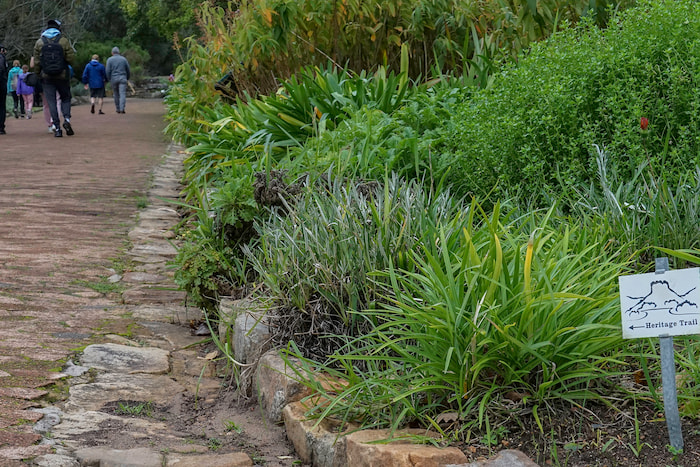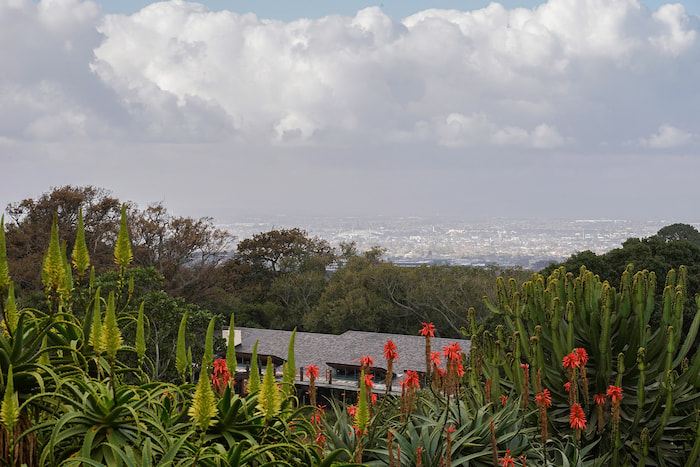Following the eye wherever it goes is the towering and astounding backside of Cape Town's Table Mountain range, which is painted bottom to top with the lush, diverse and endemic fynbos and forest covering 528 hectares. Kirstenbosch Gardens' uniqueness comes not only from its views but also from being one of the world’s largest botanical gardens, a UNESCO World Heritage Site, and thousands of different species, and its mission is to highlight and conserve endemic species. From its establishment in 1913, this biodiversity oasis has flourished and become a display of the importance and role of a healthy and indigenous environment.

The bright greens, browns, reds and yellows from the lower-lying fynbos line the twisting pathways of each trail. Fynbos is defined as the largely diverse shrublands of Southern Cape in South Africa, home to many endangered plant species. The inconspicuous role of the native shrubbery goes unnoticed by many. Still, similar to most vegetation seen anywhere, they aid in water filtration, carbon capture, and nutrient cycling, providing food and habitat for other organisms.

Many Hairy-tube Heath (Erica brachialis) plants are part of the fynbos just down the pathway. These unique flowers light up the trail through its distinctive shape and contrasting deep purple and green color. In the wild, there are less than 500 individuals, which has occurred due to factors such as being overtaken by alien vegetation, frequent fires and human development. Here at Cape Town's Kirstenbosch, the beauty of this threatened species has been well preserved within the gardens, with many of them present, highlighting their efforts and commitment to the conservation of this and many other local species of the Cape Floral Kingdom.

The winding stairs then lead up to the extraordinary tree canopy walkway, also noted as the ‘The Boomslang.’ Within the Afromontane Forest and just above the western half of the arboretum, signs filled with facts about the landscape are welcoming along into the heights of the canopy. Covering about just 0.5% of Africa, this forest is composed of many tree species, such as the Wild Peach (Kiggelaria africana), Cape Holly (Ilex mitis) and the Pigeon Wood (Trema orientalis). The ecological importance of trees such as these is huge, as they provide vital food and shelter for hundreds of animal species.

Beneath the many feet that stroll along lies many dull green to vibrant red ripening fruit on the Asparagus Fern (Asparagus densiflorus). These fruits are eaten by animals such as birds, which then disperse the seeds, continuing the longevity of the species. Additionally, they are a hub for pollinators when in bloom during the summer. Due to being endemic to South Africa, it doesn’t display any invasive inclination, unlike it does in other countries such as Australia, where it was first introduced for ornamental purposes. This focuses on the impact of non-native species away from their origins, which can quickly cause issues.

Above the fern shrubbery, short bursts of chirping echo from the wall of surrounding plant life. The sweet nectar of the Candelabra Aloe (Aloe arborescens) attracts the Greater Double-collared Sunbird (Cinnyris afer). Its standout colors against the aloe make it a fan favorite for ongoing guests. These small birds help with vegetation pollination in the canopy amongst the fynbos and eat other things like spiders and small insects.

Back-Up towards the entrance, the contrasting colors of the Kirstenbosch foliage draw a distinct line between the edge of where the gardens merge with the city of Cape Town. The annual floods of tourism at Kirstenbosch have only increased with its development and is a wonderful example of a healthy biome. The Minister of Tourism of South Africa, Derek Hanekom, described the importance of this biodiverse garden as a whole by stating, “Biodiversity and tourism conservation are tied together. If we destroy our natural assets, we destroy tourism. When we protect our natural assets, we build the tourism economy so that it is sustainable into the future.” Ecotourism has allowed Kirstenbosch to become what it is today and, in turn, allowed thousands of native species to thrive and build up a kind of paradise.
This article was published as part of the Wildlife Conservation and Photojournalism Internship with Lesley Rochat, co-owner of Shark Warrior Adventures and founder of AfriOceans Conservation Alliance.


